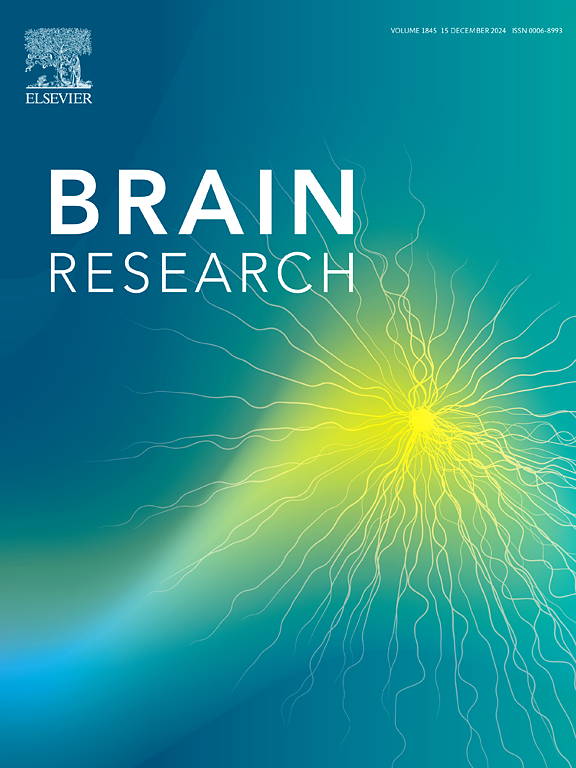The relationship between alcohol bingeing in the gestational period of wistar rats and the development of schizophrenia in the offspring adult life
IF 2.6
4区 医学
Q3 NEUROSCIENCES
引用次数: 0
Abstract
The incidence of schizophrenia in young adulthood may be associated with intrauterine factors, such as gestational alcohol consumption. This study investigated the relationship between a single high dose of alcohol during pregnancy in Wistar rats and the development of schizophrenia in the adult life of the offspring. On the 11th day of gestation, pregnant rats received either water or alcohol via intragastric gavage. Male and female offspring were subjected to behavioral tests at 30 days of age according to the maternal group. At 60 days of age, offspring received intraperitoneal injections of ketamine (ket) or saline (SAL). After the final ketamine administration, the adult offspring underwent behavioral tests, and their brain structures were removed for biochemical analysis. Alcohol binge drinking during pregnancy induces hyperlocomotion in both young female and male offspring, with males of alcohol-exposed mothers showing reduced social interactions. In adult offspring, ketamine induced hyperlocomotion; however, only females in the alcohol + ket group exhibited increased locomotor activity, and a decrease in the time to first contact was observed in the alcohol group. Cognitive impairment was exclusively observed in male animals in the alcohol group. Increased serotonin and dopamine levels were observed in male rats in the alcohol + ket group. Biochemical alterations indicate the effects of intrauterine alcohol exposure associated with ketamine in adult animals. These behavioral and biochemical changes suggest that the impact of prenatal stressors such as alcohol persists throughout the animals’ lives and may be exacerbated by a second stressor in adulthood, such as ketamine.
妊娠期酗酒与后代成年后患精神分裂症之间的关系。
青年期精神分裂症的发病率可能与宫内因素(如妊娠期饮酒)有关。本研究调查了 Wistar 大鼠妊娠期间摄入单次高剂量酒精与后代成年后精神分裂症发病率之间的关系。在妊娠的第 11 天,妊娠大鼠通过胃内灌胃接受水或酒精。雌雄大鼠的后代在出生后 30 天按母鼠组别接受行为测试。60日龄时,后代腹腔注射氯胺酮(ket)或生理盐水(SAL)。最后一次氯胺酮注射后,成年后代接受行为测试,并取出其大脑结构进行生化分析。妊娠期酗酒会诱发幼年雌性和雄性后代的过度运动,母亲酗酒的雄性后代会减少社会交往。在成年后代中,氯胺酮会诱发过度运动;然而,只有酒精+氯胺酮组的雌性后代表现出运动活动增加,而且在酒精组中观察到首次接触时间缩短。酒精组中只有雄性动物出现认知障碍。酒精 + 酮组雄性大鼠的血清素和多巴胺水平升高。生化变化表明,成年动物在宫内接触酒精和氯胺酮会产生影响。这些行为和生化变化表明,产前压力源(如酒精)对动物一生的影响是持续性的,成年后的第二种压力源(如氯胺酮)可能会加剧这种影响。
本文章由计算机程序翻译,如有差异,请以英文原文为准。
求助全文
约1分钟内获得全文
求助全文
来源期刊

Brain Research
医学-神经科学
CiteScore
5.90
自引率
3.40%
发文量
268
审稿时长
47 days
期刊介绍:
An international multidisciplinary journal devoted to fundamental research in the brain sciences.
Brain Research publishes papers reporting interdisciplinary investigations of nervous system structure and function that are of general interest to the international community of neuroscientists. As is evident from the journals name, its scope is broad, ranging from cellular and molecular studies through systems neuroscience, cognition and disease. Invited reviews are also published; suggestions for and inquiries about potential reviews are welcomed.
With the appearance of the final issue of the 2011 subscription, Vol. 67/1-2 (24 June 2011), Brain Research Reviews has ceased publication as a distinct journal separate from Brain Research. Review articles accepted for Brain Research are now published in that journal.
 求助内容:
求助内容: 应助结果提醒方式:
应助结果提醒方式:


